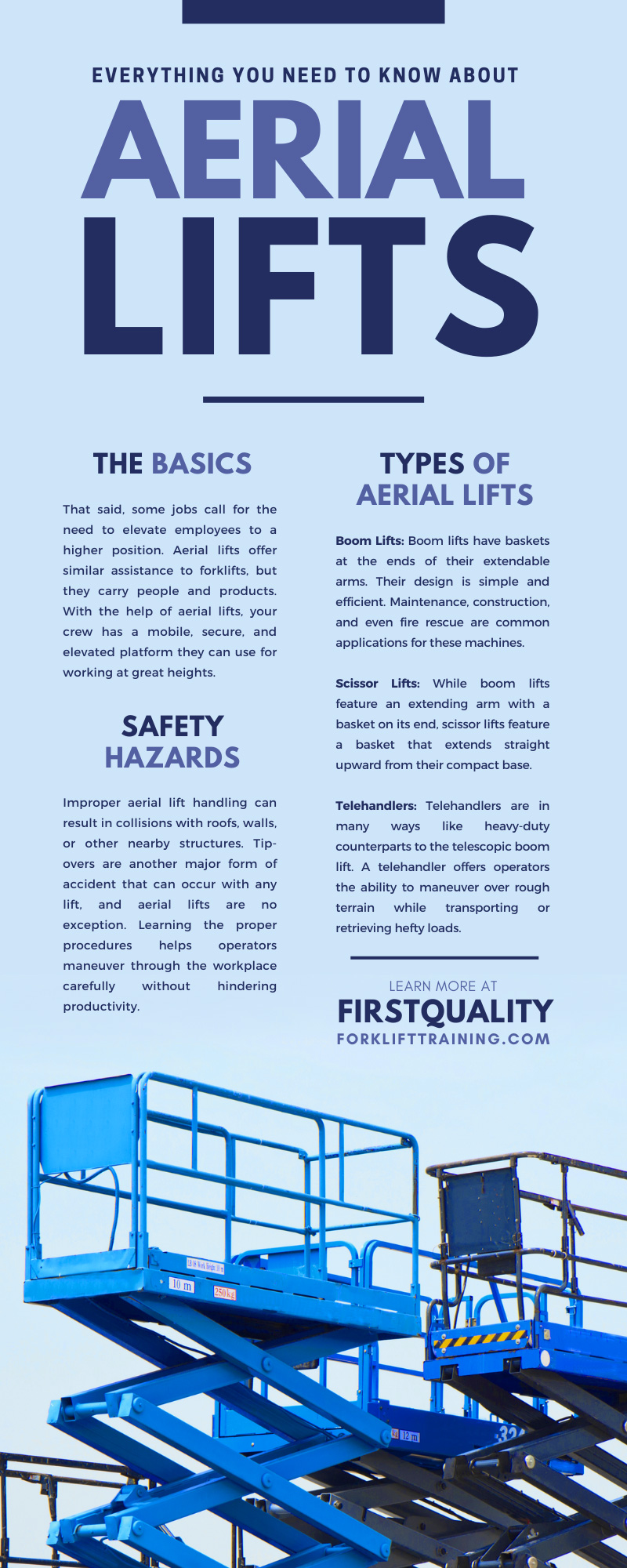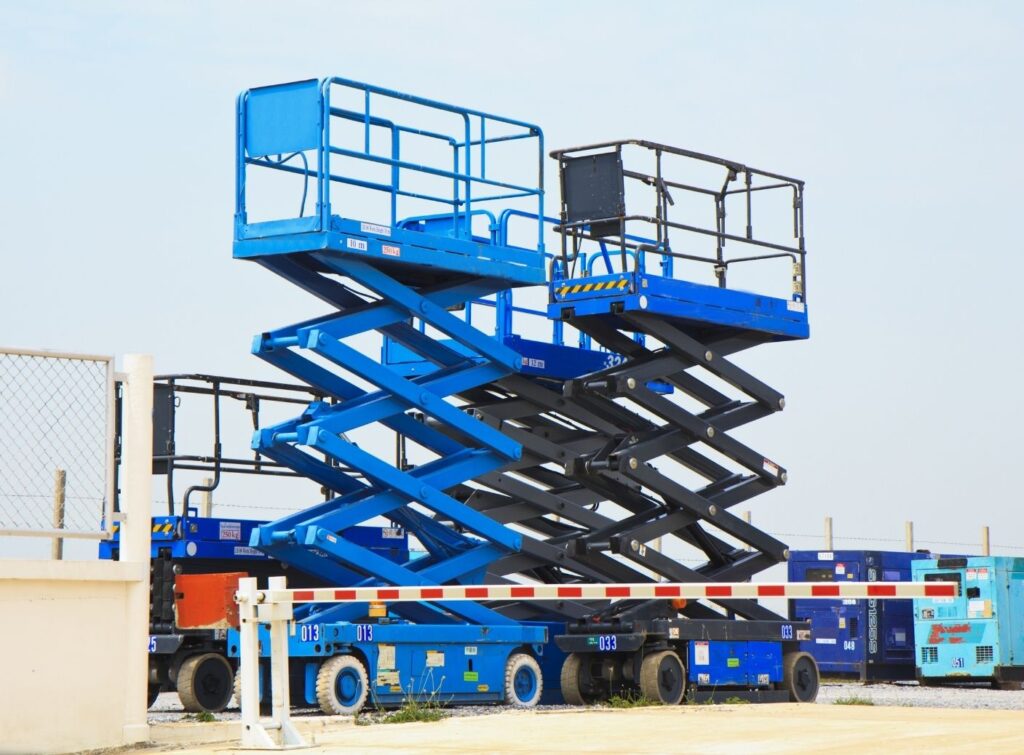Aerial Lift Training
Everything You Need To Know About Aerial Lifts
Warehouses, construction sites, and maintenance companies conduct a lot of work on the ground. However, some instances call for employees to complete work in high, hard-to-reach areas. Thankfully, aerial lifts are popular and reliable machines that fulfill such a role. If you’re a business owner, read this guide to learn everything you need to know about aerial lifts. That way, you can make an informed purchase when seeking one of these machines for your workplace.
The Basics
Forklifts assist with carrying heavy loads of materials through warehouses, construction sites, and various other workplaces. You shouldn’t use forklifts to carry employees around. In fact, sitting on the forks is a significant safety hazard. That said, some jobs call for the need to elevate employees to a higher position. Aerial lifts offer similar assistance to forklifts, but they carry people and products.
With the help of aerial lifts, your crew has a mobile, secure, and elevated platform they can use for working at great heights. Beyond transporting heavy materials, common applications of aerial lifts include conducting maintenance and painting. Before perusing the market for an aerial lift, it’s important to know the different types available to business owners.
Types of Aerial Lifts
As you can see, the basic purpose of an aerial lift is straightforward. When employees need to work in elevated areas, business owners can provide a safe way of doing so with aerial lifts. Along with considering safety, you have to think about factors, such as work environment and application, when selecting one. There are several types of aerial lifts business owners should know about, including telehandlers, boom lifts, and scissor lifts. Each of these lifts is suitable for specific conditions. So, read the summaries below to ensure you’re using the right aerial platform for your work conditions.
Boom Lifts
Boom lifts have baskets at the ends of their extendable arms. Their design is simple and efficient. Maintenance, construction, and even fire rescue are common applications for these machines. Boom lifts can come in two forms: telescopic and articulating. A telescopic boom lift, which also goes by the name “straight boom lift,” features a straight arm with the ability to extend outward and rise to high areas. Telescopic boom lifts are better for use in open work environments due to their limited maneuverability. Luckily, articulating boom lifts cover this shortcoming by offering more maneuverability around obstacles. As their name suggests, these lifts have multiple hinges along their arms, allowing operators to bend them around objects in their way.
Scissor Lifts
While boom lifts feature an extending arm with a basket on its end, scissor lifts feature a basket that extends straight upward from their compact base. Scissors lifts don’t provide as much maneuverability as even telescopic boom lifts. Still, people use them widely to conduct various tasks related to warehouses, construction sites, and maintenance work.
These work environments have made appearances on this guide already. So, what unique attributes do scissor lifts bring to the table? This type of lift doesn’t reach the heights of its extendable boom counterpart, but it will allow you to safely carry heavy loads to higher work areas without taking up excessive horizontal space.
Telehandlers
Telehandlers (aka class VII rough terrain forklifts) are in many ways like heavy-duty counterparts to the telescopic boom lift. A telehandler offers operators the ability to maneuver over rough terrain while transporting or retrieving hefty loads. This type of aerial lift also extends outward, which is another attribute it shares with the telescopic lift.
As a result, people often refer to telehandlers as “telescopic handlers.” However, telehandlers have enclosed cabins that are more similar to those of average forklifts. Thanks to their significant carrying capacity, telehandlers are commonplace in industries like agriculture and construction. Now that we’ve covered the main types of aerial lifts, we’ll address an even more important topic: safety hazards and how to prevent them in the workplace.
Safety Hazards
Any employee at the helm of an aerial lift needs the proper training and certification to work with it. An OSHA-compliant training course that focuses on aerial lifts will get employees ready to tackle their first day without making dangerous mistakes. By providing the right training, business owners can minimize the chances of common aerial lift accidents, of which there are many.
Improper aerial lift handling can result in collisions with roofs, walls, or other nearby structures. Tip-overs are another major form of accident that can occur with any lift, and aerial lifts are no exception. Learning the proper procedures helps operators maneuver through the workplace carefully without hindering productivity.
Training Note: For telehandler training, OSHA states in 29 CFR §1910.178 Subpart (l): “The employer shall ensure that each…operator is competent to operate a powered industrial truck safely, as demonstrated by the successful completion of the training and evaluation specified …” The phrase “industrial truck” refers to Class I through VII forklifts, and that last class encompasses rough terrain forklifts and telescopic booms.
Products and employees falling from the aerial platform are also potential sources of injury. Luckily, initial operator training courses thoroughly cover common forms of fall protection, such as safety harnesses. The specific safety precautions employees must follow will differ slightly between jobs and lift types, so be sure you and your team know the right steps to take for your field. Similar to forklifts, one of the most important OSHA safety standards to follow is conducting pre-shift inspections.
Safety Inspections
Even if the lift operator is impeccable at their job, various technical problems can cause accidents in the workplace. From worn components to leaking fluids, multiple things may need attention on aerial lifts. Therefore, operators have to make sure there’s nothing wrong with their machine before beginning a work shift. An OSHA-compliant training course will detail the specific methods for inspecting aerial lifts.
Besides checking areas like the tires and power supply, operators must confirm that the aerial lift controls and components are properly functioning. If the operator notices any issues, business owners must remove the lift from their workforce until they’ve officially completed the appropriate repairs or replacements. The entire work environment requires inspection too. Dangling utility lines and overhead platforms can result in aerial lift accidents when you don’t account for them. Safe lift operation requires you to optimize your workforce and your work environment simultaneously.
By understanding everything you need to know about aerial lifts, you can safely and successfully add them into your workforce. Besides caring for the lifts themselves, be sure to have the proper training materials and programs for your new hires. Through helpful resources, such as boom lift certification training, aerial lift operators can learn how to operate these machines responsibly.



This was a great and interesting article to read. I have really enjoyed all of this very cool and fun information. Thanks